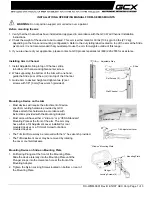
9
Remove the heat sink mounting screw (if so equipped).
Carefully remove the transistor from the heat sink of the circuit board.
Insert new transistor in the circuit board.
Solder each transistor lead, and clip off excess lead.
Replace heat sink.
Diode Removal/Replacement
Remove defective diode by clipping its leads as close as possible to diode body.
Bend the two remaining leads perpendicularly to the circuit board.
Observing diode polarity, wrap each lead of the new diode round the corresponding lead on the
circuit board.
Securely crimp each connection and solder it.
Inspect (on the circuit board copper side) the solder joints of the two “original” leads. If they are not
shiny, reheat them and if necessary, apply additional solder.
Fuse and Conventional Resistor
Removal/Replacement
1) Clip each fuse or resistor lead at top of the circuit board hollow stake.
2) Securely crimp the leads of replacement component around notch at stake top.
3) Solder the connections
CAUTION:
Maintain original spacing between the replaced component and adjacent components
and the circuit board to prevent excessive component temperatures.
Circuit Board Foil Repair
Excessive heat applied to the copper foil of any printed circuit board will weaken the adhesive that
bonds foil to the circuit board causing the foil to separate from or “lift-off” the board. The following
guidelines and procedures should be followed whenever this condition is encountered.
At IC Connections
To repair a defective copper pattern at IC connections use the following procedure to install a jumper
wire on the copper pattern side of the circuit board. (Use this technique only on IC connections).
1) Carefully remove the damaged copper pattern with a sharp knife. (Remove only as much copper
as absolutely necessary).
2) Carefully scratch away the solder resist and acrylic coating (if used) from the end of the remaining
copper pattern.
3) Bend a small “U” in one end of a small gauge jumper wire and carefully crimp it around the IC pin.
Solder the IC connection.
4) Route the jumper wire along the path of the out-away copper pattern and let it overlap the
previously scraped end of the good copper pattern. Solder the overlapped area and clip off any
excess jumper wire.
Warning and Cautions
Summary of Contents for HTX20S32
Page 12: ...11 6 Net dimension Net dimension ...
Page 13: ...12 7 Parts and Functions Parts and Functions HTF20R21 ...
Page 19: ...18 11 Circuit Diagram Circuit Diagram ...
Page 22: ...21 Circuit Block Diagram ...
Page 23: ...22 12 Circuit Explanation 0 Circuit Explanation ...
Page 24: ...23 2 N101 LA76814K 1 1 2 3 1 4 1 5 67 108 5 9 5 5 2 0 5 8 2 99 9 0 8 Circuit Explanation ...











































